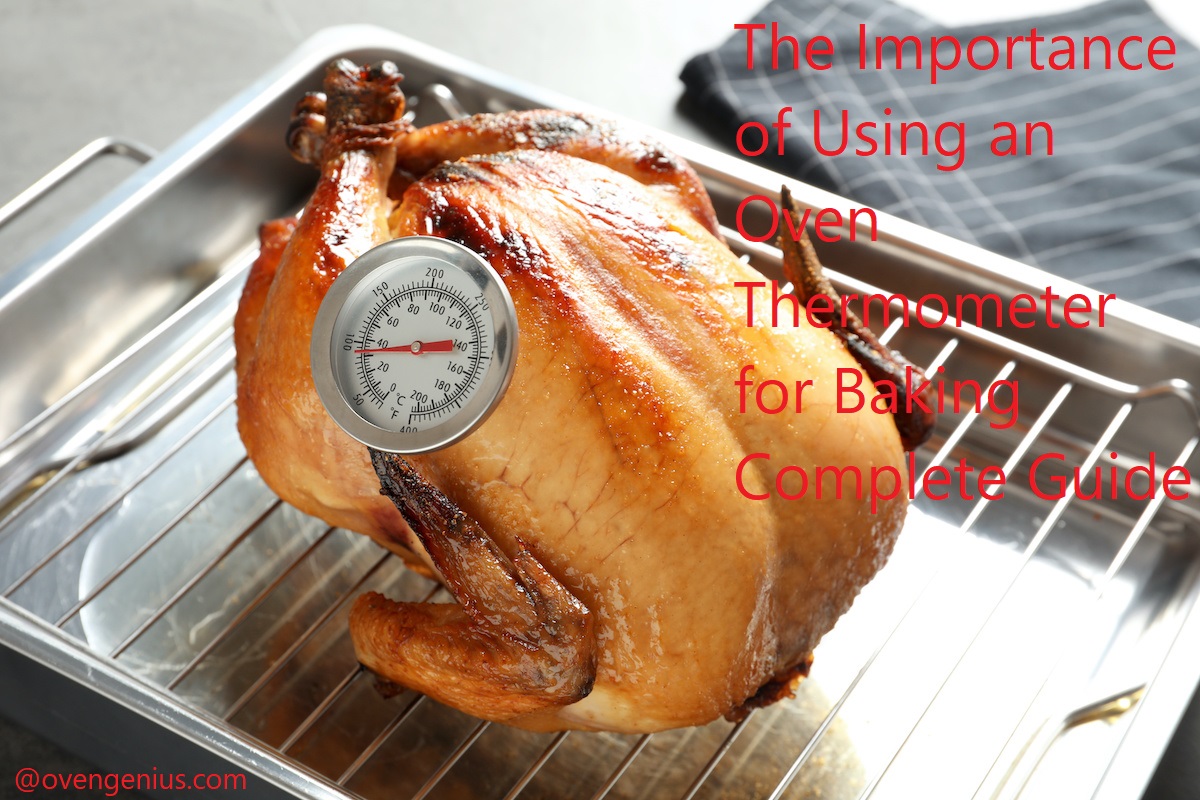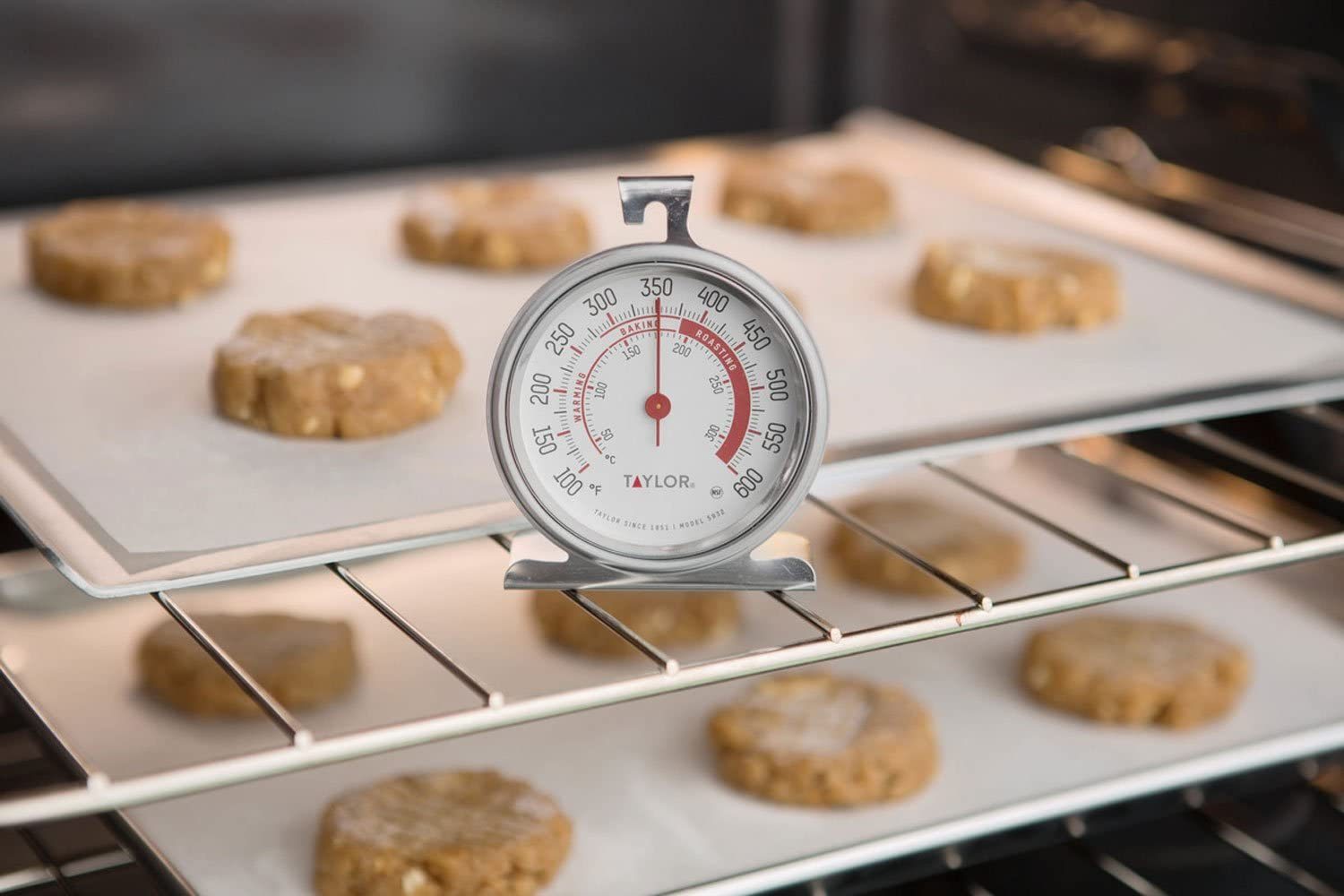Are you frustrated with your baking results? Do you want to make perfectly cooked food every time?
With the help of an oven thermometer, you can easily achieve it. This guide will provide detailed information on why and how you should use an oven thermometer for baking.
Baking is a delicate and precise art. In order for your baked goods to turn out as desired, oven temperatures must be consistent throughout the baking time. Unfortunately, many ovens are not accurate in their temperature settings, leaving you with underbaked and overbaked products. That’s why investing in an oven thermometer is important if you’re serious about baking.
The main advantage of using an oven thermometer is that it accurately reads the internal temperature of your oven. A digital thermometer provides more accuracy than the standard dial or digital display on the control panel, often indicating the exact temperature within 1°F (0.5°C). This allows you to determine if your oven is maintaining a consistent heat – something which can vastly increase your success rate when using recipes with more specific instructions as far as temperature goes.
Some thermometers even come with alarms that alert you when temperatures reach specific levels so you can adjust the thermostat accordingly without waiting until it’s too late and damaging your cake or loaf of bread has already been done- unsalvageable results due to inaccurate oven temperatures can really be soul destroying! Additionally they also come equipped with hooks that allow them to be hung from an interior rack or stand on their own on an interior shelf – plus many models have angled back panels for easy viewing from any spot in front of your appliance – If a thermometer isn’t already included with your oven manual , adding one could make all the difference for getting this part of baking perfect every single time!
Definition of oven thermometer
An oven thermometer is a device used to measure and display the temperature inside an oven. This allows for more accurate readings than using the built-in dial or indicator on most ovens. An oven thermometer is highly recommended for baking, as even the most modern ovens can be off by up to 50°F from their intended setting. Oven thermometers also come in two distinct types: dial and digital readouts. Dial types are more accurate as there is no need for calibration, but digital readouts are easier to use and can typically be set to alert users when a certain temperature has been reached.
Using an oven thermometer is beneficial in a few ways: accuracy, economizing time and energy, knowing if an oven has fluctuated between baking cycles, ensuring safety while baking and providing consistent results each time when the same recipes are used. The use of a thermometer makes all recipes prepared in an electric or gas oven much easier with more consistent results that taste great every time they are made!

Importance of using an oven thermometer in baking
Using an oven thermometer when baking is essential for getting the correct temperature for different recipes. Certain recipes call for baking at different temperatures, such as 300°F (149°C). Different ovens heat differently and without a reliable gauge, like an oven thermometer, it can be hard to know the exact temperature of your oven.
Accurate temperature control is key to successful baking and using an oven thermometer helps you easily determine your oven’s actual temperature setting. Accurate internal temperature monitoring also ensures that food is cooked evenly, something that can be challenging when using an inaccurate built-in thermostat or pre-existing features in some electric or gas ranges. With an oven thermometer in place, you will know if the set temperature is not accurate so you can quickly make adjustments during cooking time, resulting in better end products all around!
Another advantage of using an oven thermometer over relying on the built-in thermostat or pre-existing features in some ranges is that it reduces the guesswork of setting appropriate temperatures for specific recipes. Using a thermometer also eliminates lengthy and tedious testing procedures with extra ingredients to test temperatures which can result in wasted ingredients. Having your own reliable and accurate monitoring device inside of your oven will eliminate all of these issues while guaranteeing perfect dishes every time!
Why Use an Oven Thermometer
Inaccurate oven temperatures are often overlooked as a reason for bad baking results but no matter what type of recipe you make, precision is key for the best tasting results. An oven thermometer helps you achieve that exact temperature your recipe calls for, leading to better baked goods.
An oven thermometer should be used to check the accuracy of your oven temperature setting and can still be beneficial even if your baking times remain the same. This is especially important when baking delicate items such as cakes and pastries, where precise temperatures make a huge difference to their final texture.
Over time, ovens tend to drift in their performance and need recalibrating – this means that the temperature displayed on your dial or settings may not in actuality reflect the true inner oven tempearature. Cooking food at an incorrect temperature can affect how it is cooked and any change in cooking time or temperature could lead to under-baked or over-baked ingredients as as well an off taste. To ensure that your recipes come out correctly every single time, it’s always best practice to use an oven thermometer while baking.
Inaccurate oven temperature readings
An oven thermometer is an essential tool for successful baking and is used to measure the oven’s internal temperature. Many home bakers assume that the temperatures indicated on their oven are 100% accurate, but this is usually not the case. Oven thermostats can be off by as much as 50°F, leading to either undercooking or overcooking in your recipes. Inconsistent heating can also cause baked goods to be underdone in certain areas; for example, a cake may have a firm and golden edge with a soggy center.
Using an oven thermometer ensures more accurate temperature readings, resulting in perfectly cooked treats every time! An oven thermometer should be placed on the center rack of your oven while it preheats to ensure that temperatures stay consistent throughout your bake session. This will help prevent you from opening the door too many times and affecting your dish’s overall results.
Effects of inaccurate oven temperature on baked goods
Cooking followers, from amateur enthusiasts to professional chefs, understand that baking is a precise art form. The outcome of any recipe can be dramatically affected by even small variations in oven temperature. Though many modern oven models have digital thermometers and sensors mounted on the walls of the oven, it’s still recommended that you use an oven thermometer for baking for more exact temperature control.
When baking with an unreliable or less-than-accurate oven thermometer, the results can be disastrous in both the short term and long term. If a recipe requires a certain temperature to complete successfully and your oven isn’t accurate enough to provide you with those results, your cookie or cake might not be successful on the first attempt…or any subsequent attempts if you aren’t aware of how far off you were! Inaccurate temperatures can yield several effects on baked goods:
- Under-cooking – This is caused by temperatures that are too low resulting in doughy centers, runny frostings and soggy pastries.
- Overcooking – This is caused by temperatures that are too high resulting in burnt edges and dry crumbs.
- Unpredictable Results – More dramatic changes to temperatures can result in poor cake rising with flat surfaces, hard cookies due to excess spreading and muffins with peaked tops.
Using an separate oven thermometer for baking not only helps your recipes turn out perfect every time but it gives you insight into what may have gone wrong with failed bakeries projects in the past as well as helping you avoid problems going forward!
Advantages of using an oven thermometer
Using an oven thermometer for baking offers several advantages for home bakers. Firstly, since the temperature can be varied so precisely with an oven thermometer, it allows more flexibility when baking – something especially important if you are baking high-precision recipes. It also can allow you to accurately verify that your oven is operating within its temperature range rather than having to take its word for it, leading to more consistent and reliable results when you bake.
Additionally, an oven thermometer is also useful because it ensures that your baked goods will not be underbaked or overbaked – being able to set the exact temperature you want and monitor it in real time will enable you to achieve perfect results each and every time without fail. Furthermore, an oven thermometer is relatively inexpensive – making it a worthwhile investment for any home baker who wants their baked goods to always turn out perfectly!

How to Choose an Oven Thermometer
When shopping for an oven thermometer, it’s important to have an accurate device that is easy to read. It is also important to choose a thermometer that is designed for high temperatures, so you know it can withstand the 450°F or higher temperatures used in baking.
Look for a device with an extra-long stem, so you can slide it into the back corners of your oven. Consider investing in digital thermometers; they provide more accurate readings than the standard dial versions. Make sure your thermometer measures both Celsius and Fahrenheit, so you’re prepared for any recipe.
With a digital display and extra-long stem, digital oven thermometers are easy to read and operate quickly. The display will let you check your oven’s temperature even from across the kitchen!
Types of oven thermometers
Oven thermometers come in two main types. Snap-dial handheld models feature a round face with a temperaturereading activated by a motorized needle, while digital thermometers show the temperature in numeric form on an LCD display. Both types of thermometers must remain in the oven when giving readings and should be situated near the middle of the oven, away from any walls or heating elements. This will ensure accuracy and consistency with the temerature.
Aside from stationary oven thermometer models, there are also probe varieties that can be placed directly into food being cooked and monitored remotely via a long lead attached to the base unit outside of the oven.
Additional features to look out for when purchasing an oven thermometer include resistence to extreme heat and compatibility with temperatures reaching high heat settings (over 800 degrees Fahrenheit). Oven thermometers can also come equipped with preset alarms that go off at pre-programmed settings alerting users when certain temperatures have been reached; these are especially useful for labs and bakeries, as they lessen manual monitoring time.
Features to consider when choosing an oven thermometer
When choosing an oven thermometer, there are several features that you should consider. Firstly, it should be easy to read, preferably with large and clear markings and numbers. Secondly, it should be durable, as this item is regularly exposed to high temperatures and therefore needs to be able to withstand them. Additionally, an oven safe model is a must as they can resist much higher temperatures than a general-use thermometer. Lastly, some models come with other features such as temperature adjustable alerts and backlit LCD screens which help in easily monitoring the temperature during baking.
Brands of oven thermometers to consider
When looking for oven thermometers there is no shortage of choice. Selecting the right one for you depends on your budget and the extra features you are looking for.
Digital read-out thermometers allow quick readings with a digital display that shows the actual temperature inside the oven. These range in price from $10 – $50 and usually come with a metal cord attached to the thermometer so it can be suspended or placed on top of metal racks in the oven.
One example of a digital read-out thermometer is Taylor’s Digital Oven Thermometer, which ranges from 32°F – 572°F, has an adjustable alarm that beeps when food reaches an appropriate temperature and includes a timer. Other models offer remote probes so readings can be taken without opening the door and disturbing heat levels within the oven.
Analog dial-type thermometers are less expensive than digital varieties ranging from $1 – $30 and generally have donut shaped faces that indicate temperatures to which they were pre-calibrated in various ranges such as 150°F to 550°F (65°C to 285°C). Accuracy should still be checked every couple of months by boiling water, then submerging the tip of your thermometer in it, comparing it with its marked calibration point at 212°F (100°C).
The Smokehouse Chef carries two types of dial-type thermometers: The Classic Oven Thermometer runs from 100℉ – 600℉ while their Artisan model starts at 150℉ through 550℉ range with large print characters making readability easier even under low light conditions like an oven interior.

Conclusion
In conclusion, it can be seen that having an oven thermometer on hand to ensure accurate temperatures is essential to consistent, successful baking outcomes. If a recipe calls for pre-heating or cooking temperatures beyond the basic settings of a standard oven, it is most beneficial to use an oven thermometer. It can help to prevent over-cooking or burning food, as well as protecting potentially expensive kitchen equipment from damage in the long run.
With this guide, it is clear that using one of these tools will result in delicious meals with the desired degree of doneness every time.
FAQ’S
What is the importance of oven in baking?
The oven is essential in baking as it provides the heat necessary to cook and brown the food.
What is a thermometer in baking?
A thermometer in baking is a tool used to measure the temperature of the food or the oven to ensure that the food is cooked to the desired level.
What is the importance of monitoring the heat and temperature of an oven when baking?
Monitoring the heat and temperature of an oven is crucial in baking as it helps ensure that the food is cooked evenly and thoroughly without overcooking or undercooking.
What kind of thermometer is best for baking?
The best thermometer for baking is a digital instant-read thermometer, as it provides a quick and accurate temperature reading.
Are oven thermometers good?
Yes, oven thermometers are good tools to ensure that the oven is maintaining the correct temperature for baking.
Can you use an oven thermometer?
Yes, an oven thermometer can be used to measure the temperature of the oven and ensure that it is accurate.
Which oven is used for baking?
A conventional oven is typically used for baking.
What is the most important in baking?
Precision and accuracy are the most important aspects of baking, especially in terms of measurements, temperature, and time.
What is the best way to use an oven thermometer?
The best way to use an oven thermometer is to place it in the center of the oven, turn on the oven to the desired temperature, and wait for the thermometer to reach the same temperature to ensure accuracy.
How accurate are oven temperatures?
Oven temperatures can vary depending on the make and model of the oven, but using an oven thermometer can ensure that the temperature is accurate and consistent.
See Also:
- Best microwave/convection oven
- Best oven for baking
- Best oven liner
- Best oven mitts
- Best oven safe skillet


